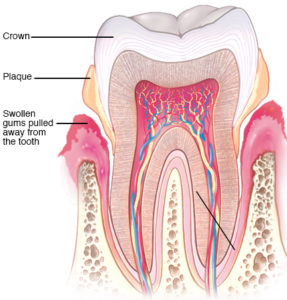Header logo
header top contact widget
Dry Mouth
You CAN Avoid Gum Disease – Know How It Forms & Easy Prevention Tips
Posted on Dec 14, 2018 by William J. Claiborne, DDS MS
I know of so many friends and family members who have avoided or minimized serious health problems (and perhaps even death) by taking preventive measures when it c omes to their health. Annual screenings (such as mammograms, prostate checks, pap smears, and colonoscopies, to name a few) have enabled countless people to simply treat or avoid serious conditions and get back to their lives and loved ones.
omes to their health. Annual screenings (such as mammograms, prostate checks, pap smears, and colonoscopies, to name a few) have enabled countless people to simply treat or avoid serious conditions and get back to their lives and loved ones.
When we “take charge” of our health, we can also avoid the time and expense required for treating problems that could have been prevented in the first place. For example, not smoking helps us avoid the risk of many cancers and respiratory diseases. Eating a healthy diet and regular exercise lowers our risk for heart disease.
I believe that when people know what to do to avoid problems, they can be proactive in their health. This is especially true for periodontal (gum) disease. What I find is that many individuals are simply not familiar with effective prevention measures nor the signs and symptoms of this infectious disease.
People are often surprised to learn that gum disease first begins without obvious symptoms. Even when it’s fully underway, the warning signs are often ignored or deemed “normal.” For instance, seeing blood in the sink when brushing is a sign that the gums are weak and inflamed, even though some people assume this means they’re doing a good job. (BTW, you should NEVER see blood in the sink when brushing!)
The path that leads to gum disease can easily be bypassed, however. The process of how it forms and progresses is:
• Oral Bacteria Overload: Bacteria in our mouths is unavoidable. It is on our food, utensils, the glasses we drink from and the pencil we hold between our teeth. Because the mouth is a warm, dark, and moist environment, it offers an ideal setting for bacterial growth. Although certain bacteria levels are manageable through brushing, flossing, and saliva flow, problems begin when too much bacteria accumulate and remain in the mouth.
• Plaque: Without regular brushing, flossing, sufficient saliva flow, and low-sugar diet, oral bacteria can reproduce rapidly. Their accumulation can quickly form a sticky film that you feel on teeth (a ‘fuzzy’ feeling), known as plaque.
• Tartar (or Calculus): In just 48 hours, plaque can harden on teeth. This is known as tartar (or calculus) and is actually a cement-hard mass of oral bacteria. Like plaque, tartar will continually grow as the bacteria reproduce. Their destruction includes boring into tooth enamel and eating away at gum tissues.
• Gingivitis: This is actually the first phase of gum disease. At this stage, gum tissues are under attack and become sore. It can cause the gums to bleed when brushing and gum tenderness. You may experience an aching sensation in some areas. Your breath will be bad more often. By taking proper measures as soon as you notice these symptoms, the gums can be restored to a healthy state. However, there is a fine line between being able to undo gingivitis and its progression to gum disease.
• Gum Disease: At this level, the gums are inflamed and tender and red rather than a healthy pink color. Your breath will be unpleasant on a consistent basis. The gums may also begin to pull away from the base of some teeth, exposing sensitive tooth root areas. As the inflammation progresses, pus pockets may form at the base of some teeth. Without treatment, teeth will loosen as the bacteria destroy the structures that support tooth roots. Eventually, tooth removal may be required.
Almost half of American adults have some level of periodontal disease, which is also the nation’s leading cause of adult tooth loss. Yet, it’s one of the most preventable diseases with simple measures.
It has also been found that the bacteria of gum disease can enter the bloodstream, triggering systemic inflammation. Gum disease has been linked to a long list of serious health problems. These include heart disease, some cancers (including prostate, lung, and pancreatic cancers), stroke, preterm babies, arthritis, diabetes, Alzheimer’s disease and erectile dysfunction (ED).
Twice daily brushing (at least two minutes each time), daily flossing, drinking plenty of water, and limiting sweets and caffeine (including colas, tea, and coffee) are simple ways to keep your mouth healthy between regular dental check-ups and cleanings. Remember that your 6-month check-ups are very important. During these visits, any tartar that has accumulated can be removed and signs of early gum disease can be noted – and promptly resolved.
These simple steps can help you avoid the discomfort of gum disease as well as the devastation of losing your teeth and having to decide on replacement. These procedures – and the expense – can be avoided. And, contrary to what some people believe, losing teeth is NOT a natural part of the aging process. With proper care, you can easily enjoy a smile of natural teeth throughout your lifetime.
If you are experiencing symptoms of gingivitis or periodontal disease, call our Asheville periodontal office at 828-274-9440. As a periodontist, I have specialized skills to restore your oral health and customize a program to help you keep it at its best.
Have GOOD Breath For The Holidays! And Ban BAD Breath Forever!
Posted on Dec 05, 2018 by William J. Claiborne, DDS MS
The holidays are a time when friends and family bring us closer together. Whether sitting side-by-side at the table or in close conversations at cocktail parties, we find ourselves a little more conscious about our breath odor than perhaps we normally would be.
Of course, we’ve all encountered that individual who has the memorable bad breath. And, what a terrible impression that leaves, which tends to be forever associated with that person. Fortunately, there are easy ways to avoid having bad breath in these situations and to have fresher breath throughout the year.
It is important to know that bad breath is typically the result of accumulated oral bacteria. It’s as simple as that. And, it’s as difficult as that. Like aging garbage, bacteria in the mouth that amass to high numbers create an odor — a stinky odor.
There are a number of things that contribute to the ability of these icky organisms’ ability to reproduce. One that may surprise you is having a dry mouth.
A dry mouth may seem less inviting as a breeding ground for bacteria since they typically thrive in environments that are warm, moist, and dark. However, when saliva flow is unable to efficiently cleanse bacteria buildup from the mouth, they are easily able to reproduce.
A dry mouth is rather common today. A large percentage of common medications (including anti-depressants, decongestants, and anti-histamines) have a side effect of oral dryness. Too, many beverages contribute to a dry mouth. These include colas, coffee, tea, and those containing alcohol.
Another way that oral bacteria can run rampant has to do with our oral hygiene routines. To be truly thorough in cleaning tooth surfaces, it is recommended to spend two minutes per brushing, twice a day. That applies to both manual and electronic toothbrushes.
Even so, it is estimated that nearly one-third of American adults brush their teeth for an insufficient amount of time. Even worse, about that same amount fail to brush twice a day. This means that a frightening number of bacteria are left to grow and thrive in these mouths.
When you factor in that brushing only tackles about half the amount of bacteria in the mouth, you’re left with a tremendous amount that are able to grow and thrive. You may be surprised to learn that the tongue harbors anywhere from 58 to 65 percent of the bacteria in your “oral cavity.”
Oral bacteria love to embed in the tiny bumps and grooves of the tongue since they are not easily dislodged. Thus, it’s necessary that the tongue be involved in your oral hygiene regimen at home to keep bacteria levels under control.
Some toothbrushes have a “tongue scraper” on the reverse side of the bristles that’s an effective option. Or, you can just brush your tongue with the bristles after you’re teeth are brushed. Be sure to reach towards the back of the tongue where the majority of bacteria exist.
Another challenge for maintaining control of oral bacteria have to do with the eating habits of the American population. While “three squares” were once the norm, today’s American has more of a “grazing” schedule.
For example, your “average Joe” may have breakfast, a mid-morning latte, lunch, a mid-afternoon snack, dinner, and a bowl of popcorn or ice-cream while watching television. Throw in coffee, colas, and tea in with this consumption, you have a pattern that works against your smile.
Although saliva is designed to rinse the mouth consistently during the day, this frequency in eating poses more of a challenge than it is capable of handling. Too, food has more opportunities to becomes stuck between teeth. For those who do not floss daily, these bits are left to rot, adding to bacterial growth.
So, how do you avoid being “the one who has bad breath”? It begins with your time at the sink. Slow down! Spend at least two minutes each time you brush. Don’t scrub your teeth but allow the brush to sweep over them, especially near the gum line. Spend extra time, too, going over the tops of large teeth that have deep grooves.
Tend to your tongue. Either brush your tongue or use a tongue scraper. You’ll be removing a tremendous amount of bacteria that can form bad breath.
Floss daily. If it’s difficult for you, ask our hygienist to work with you on your technique so it is comfortable and efficient. You can also purchase an electronic flosser (water flosser). These are affordable and proven to be just as effective as manual flossing.
Drink plenty of water throughout the day. If you take medications that are drying, consider using an oral rinse formulated to replenish moisture (available over-the-counter). If you’re having a beverage that contains alcohol, drink a glass of plain water between each drink. This not only adds moisture to the mouth, it will dilute the acids in the mouth for less potential damage to tooth enamel (and lessen staining).
Not mentioned prior but very important to avoiding oral bacteria buildup – keep your six-month dental cleanings and exams without fail! These visits remove plaque and calculus (or tartar), which are nothing more than gathered bacteria.
These small measures will help you avoid cavities, gum disease, AND be the one who’s easy to get close to at any gathering! If you have tender gums, gums that bleed when brushing, or frequent bad breath, however, you should arrange to see a periodontal specialist as soon as possible.
A periodontist is a dental specialist who has advanced training in the diagnosis and treatment of all stages of periodontal (gum) disease. He or she is your best way to have a confident, “get close” smile! Call our Asheville periodontal office at 828-274-9440 to learn more.
If You Smoke, Your Smile Takes The First Hit.
Posted on Nov 06, 2018 by William J. Claiborne, DDS MS
First, let me assure you that this article is NOT a lecture about the health hazards associated with smoking cigarettes. We assume you’ve heard many of those statistics and warnings before.

Signs of gum disease
However, as a Periodontist, I would be remiss if I didn’t begin by sharing the rather unique view I have of what it does to the inside of an adult mouth. With this in mind, I’ll share some perspectives you may not know.
When it comes to a smile, be aware that smokers have a greater risk of periodontal (gum) disease, more frequent bad breath, higher plaque levels, stained teeth, and slower healing following extractions, gum treatment and oral surgery.
The primary reason for this is because smoking has a drying effect on oral tissues. Without moisture that moves bacteria out of the mouth, this creates an ideal breeding environment for oral bacteria.
As oral bacteria reproduce and multiply in the mouth, the bacteria become infectious and inflame gum tissues. This is the beginning of gum disease. In the initial stage, known as gingivitis, symptoms include frequent bad breath, tender gums, and gum tissues that bleed easily when brushing.
As it progresses, bad breath becomes persistent, gum tissues turn red, and pus pockets form at the base of some teeth. Eventually, this potent bacteria attack bone structures that support teeth and tissues surrounding tooth roots. This causes teeth to loosen and can lead to the need for tooth removal.
Gum disease is the nation’s leading cause of adult tooth loss. You may be surprised to learn that losing teeth is highly detrimental to your overall health. Studies show that people who wear dentures die ten years earlier than those with natural teeth, on average. Denture wearers take more medications, have more gastrointestinal problems, and are less socially active.
Smoking is also attributed to nearly a third of all cancer diseases and deaths. Pregnant women who smoke have a greater risk for first-trimester spontaneous abortion, preterm births, low birth weight babies (under 5.5 lbs) and sudden infant death syndrome (SIDS). Women who smoke are risk having early menopause while men who smoke are at higher risk of impotency.
On average, smokers decrease life expectancy by 10–15 years. That’s pretty scary. As hard as it is, kicking the habit is well worth the benefits, which can be obvious almost immediately. These often include:
• Immediately: You halt the contribution of ‘second-hand smoke,’ which puts at least 50 carcinogens and other harmful chemicals in the air. If you have children, you’ll eliminate them waking up with ‘smoker’s cough.’
• Within 2 days: The sense of smell and taste return and damaged nerve endings begin to regenerate.
• Within 3 days: Breathing becomes easier with fuller air intake as the lungs start to repair.
• Within 2 weeks: Blood circulation in the gums is restored. The risk of heart attack declines.
• Within 6 weeks: Overall circulation has improved, walking has become easier and your chronic cough has cleared.
In our periodontal dental office, we don’t lecture our patients. We respect them and work with each on an individual basis. Our goal is to help you keep your smile in good shape, keep your natural teeth, and avoid the hazards of periodontal disease.
For those who have lost natural teeth, a periodontist has advanced training in the diagnosis and placement of dental implants in addition to the treatment of all stages of gum disease.
If you are experiencing signs associated with periodontal disease, the condition will only worsen without treatment. The earlier you treat gum disease, the less-involved treatment will be. Call 828-274-9440 to schedule an initial appointment. It is not necessary to be referred.
A Dry Mouth Can Contribute To Gum Disease
Posted on Oct 03, 2018 by William J. Claiborne, DDS MS
An estimated 47 percent of American adults have some form of periodontal (gum) disease, which is the nation’s leading cause of tooth loss. Missing teeth lead to a long list of problems, from gastrointestinal to psychological. Some studies even indicate that the number of natural teeth a person has is indicative to their lifespan.
Some medications, age, and smoking along with certain foods and beverages can lead to oral dryness. A dry mouth enables oral bacteria to linger and multiply. The longer bacteria remain in the mouth, the faster they are able to reproduce.
A buildup of this bacteria creates a sticky film, known as plaque. While daily brushing and flossing curtail the accumulation of bacteria, an adequate flow of saliva helps to keep bacteria levels under control throughout the day.
Your saliva is more than just moisture in the mouth. It is the first stage of the digestive process and helps you to chew and speak. However, modern science is also looking to saliva to reveal a number of health problems.
Saliva tests can now use the type and quantity of oral bacteria to reveal if you are at greater risk for developing gum infections. Additionally, research is using saliva to reveal the early presence of breast cancer, oral cancer, ovarian cancer, pancreatic cancer, Sjogren’s syndrome, and indicate the presence of tumors in the body and where they are located.
There is an intricate connection between your oral health your overall health. For decades, researchers have studied the link between the bacteria of periodontal disease and heart disease, diabetes, stroke, arthritis, preterm babies, and some forms of cancer.
Obviously, maintaining good oral health is important. And, it’s clear that adequate saliva flow is a beneficial component in this effort. To combat dry mouth, it is recommended that you drink plenty of plain water throughout the day. Consider using an oral rinse especially formulated for dry mouth and be dedicated to your brushing and flossing routine at home.
Because your 6-month check-ups and cleanings are structured to remove build-up that has accumulated between visits, they appointments help you to minimize or eliminate damage to teeth and gums.
It is estimated that about 40 percent of Americans take at least one type of medicine that causes oral dryness. If you take medications that are drying to oral tissues, ask your doctor if there are alternatives without this side effect. Some medications that have a particularly drying effect include antihistamines, aspirin, asthma medications and ‘cough and cold’ syrups.
To check the level of tooth loss on a long list of prescription medications, use the link below. For example, this shows Stelara with only 1 case of tooth loss but Prednisone has 436 cases and Zometa has 1,571.
http://www.ehealthme.com/symptom/tooth+loss
At each appointment, remember to update us on all the medications you take (both prescription and over-the-counter). We know your goal is to avoid gum disease and subsequent tooth loss. Knowing your medical and dental history and list of medications can help us be more proactive on your behalf.
If you have concerns about the health of your gums or have already experienced tooth loss, begin with a consultation. Call 828-274-9440 or tap here to begin.
Recent Posts
Categories
Archives
- September 2024
- August 2024
- July 2024
- June 2024
- May 2024
- April 2024
- March 2024
- February 2024
- January 2024
- December 2023
- November 2023
- October 2023
- September 2023
- August 2023
- July 2023
- June 2023
- May 2023
- April 2023
- March 2023
- February 2023
- January 2023
- December 2022
- November 2022
- October 2022
- September 2022
- August 2022
- July 2022
- June 2022
- May 2022
- April 2022
- March 2022
- February 2022
- January 2022
- December 2021
- November 2021
- October 2021
- September 2021
- August 2021
- July 2021
- June 2021
- May 2021
- April 2021
- March 2021
- February 2021
- January 2021
- December 2020
- November 2020
- October 2020
- September 2020
- August 2020
- July 2020
- June 2020
- May 2020
- April 2020
- March 2020
- February 2020
- January 2020
- December 2019
- November 2019
- October 2019
- September 2019
- August 2019
- July 2019
- June 2019
- May 2019
- April 2019
- March 2019
- February 2019
- January 2019
- December 2018
- November 2018
- October 2018
- September 2018
- August 2018
- July 2018
- June 2018
- May 2018
- April 2018
- March 2018
- February 2018
- January 2018
- December 2017
- November 2017
- October 2017
- September 2017
- August 2017
- July 2017
- June 2017
- May 2017
- April 2017
- March 2017
- February 2017
- January 2017
- December 2016
- November 2016
- October 2016
- September 2016
- August 2016
- July 2016
- June 2016
- May 2016
- April 2016
- March 2016
- February 2016
- January 2016
- December 2015
- November 2015
- October 2015
- September 2015
- August 2015
- July 2015
- June 2015
- May 2015
- April 2015
- March 2015
- February 2015
- January 2015
- December 2014
- November 2014
- October 2014
- September 2014
- August 2014
- July 2014
- June 2014
- May 2014
- April 2014
- March 2014
- February 2014
- January 2014
- December 2013
- November 2013
- October 2013
- September 2013
- August 2013
- July 2013
- June 2013
- May 2013
- April 2013
- March 2013
- February 2013
- January 2013
- December 2012
- November 2012
- October 2012
- September 2012
- August 2012
- July 2012
- June 2012


